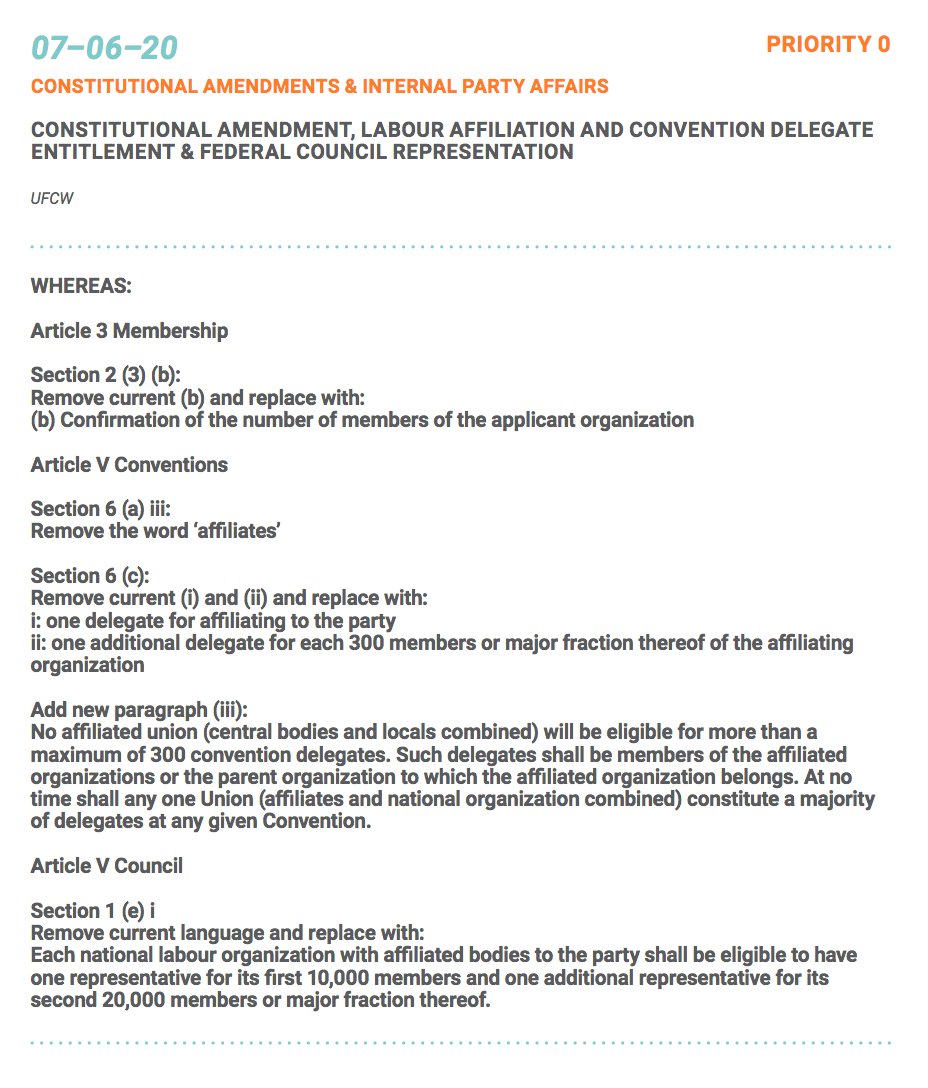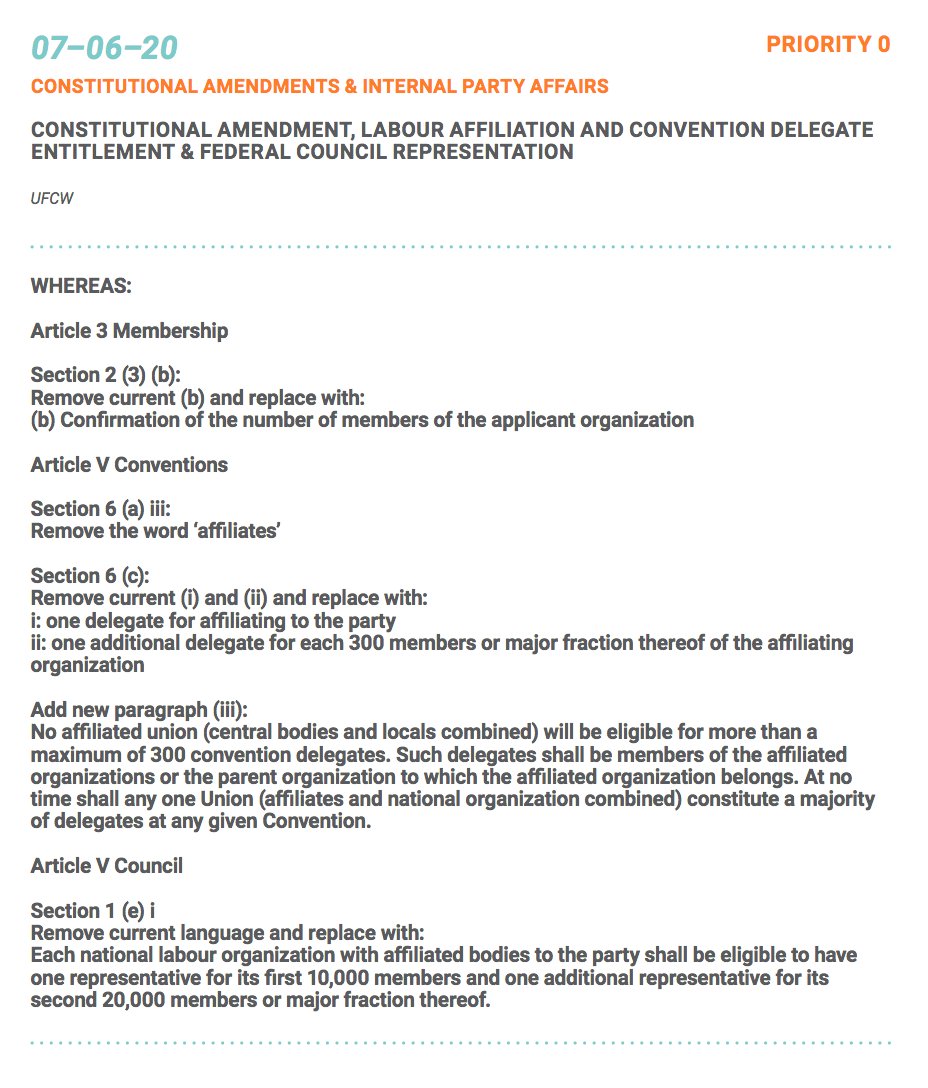
Last weekend @NDP convention delegates adopted a constitutional amendment on labour affiliation & convention delegate entitlement. In this 🧵, I try to make sense of the change by providing some historical context for the #NDP-union relationship.
#canlab #cdnpoli
#canlab #cdnpoli

.@CanadianLabour is a founding partner of the #NDP having played a significant role in the formation of the party in 1961. But the relative strength of labour’s institutional ties has varied over time.
At the @NDP founding convention in 1961, 35% of delegates represented affiliated unions. For the first few decades thereafter, union delegates typically made up a quarter of NDP convention attendees.
While several researchers have concluded that labour was willing to provide strong financial backing to launch the #NDP without demanding much institutional power in return, after the party’s first few electoral outings, labour affiliates did begin to demand greater influence.
By the late 1960s, unions were calling for increased representation in party structures and in 1969 the #NDP Federal convention voted to expand the size of the party’s federal council to include one representative from each of the 12 largest affiliated unions.
Between 1975 and 2002, unions contributed an average of $1.9 million annually to the #NDP, representing 18.4% of the party’s revenues. Much of this revenue came through the monthly per capita donations of union affiliates.
In election years, that avg increased to $3.7 million, or 28.1% of overall party revenue. Not only were unions an important source of funding for the #NDP, but labour also played a critical role in providing research, campaign staff, and organizers at election time.
There has never really been a “golden age” of NDP-union relations. Despite widespread support from industrial union leaders and provincial federations of labour to launch the party in 1961, the relationship has always been organizationally weak.
In relative terms, the NDP-labour link has never come close to matching the strength of labour-social democratic party ties in Britain, Australia, and across Europe. In fact, at its peak, union member affiliation to the @NDP reached just 14.6% in 1963.
The @NDP’s initial affiliation structure, which required unions to affiliate at the local rather than national or intl level, severely undermined the party’s ability to grow its affiliate base since it required thousands of locals, rather than dozens of parent unions, to sign on.
This cumbersome structure, however, was consciously chosen by the party’s founders who were trying to avoid both internal and external charges of labour domination through bloc voting at party meetings and conventions.
The architects of the @NDP determined that at party conventions, each delegate would have one vote, but the formula for allocating delegates to union affiliates was weighted differently.
For example, a riding association would be entitled to one convention delegate for its first 50 members, one for each of the next 50 members up to 200, then one delegate for each 100 members thereafter.
In contrast, union local affiliates would only be allocated one delegate for every one thousand members or major fraction thereof. If avoiding labour domination was the goal, it worked almost too well.
The structure in part, helped to produce an affiliated membership that was drawn almost exclusively from industrial unions and consistently regionally skewed.
While union affiliation numbers in the party’s first few years were disappointing, the situation only went from bad to worse. The share of NDP-affiliated union members dropped to 10.4 per cent in 1974 and to 7.3 per cent in 1984 amid the growth of public sector unions.
With the notable exception of @cupenat, formal institutional ties between public sector unions and the party have been few and far between. Those that did exist were largely set ablaze in the 1990s as a result of unpopular NDP provincial governments.
The 04/06 campaign finance reforms prompted the NDP to alter its constitution to do away with per capita payments by unions and instead required them to simply demonstrate that union members were also party members for the purpose of calculating convention delegate entitlement.
Despite the fact that union affiliation did not require any per capita payments under this system, affiliation numbers continued to dwindle. @SteelworkersCA @UFCW @CUPEnat & @MachinistsUnion have been the most loyal #NDP allies.
In an effort to reverse this trend, union delegates at the party’s 2021 convention successfully pushed for a constitutional amendment granting affiliate delegate positions based on the size of the union, rather than the number of card-carrying New Democrats in the union. 

The change was promoted by supporters as an opportunity to reinvigorate labour participation in the party through the expansion of affiliated delegate spots, but criticized by opponents as a disincentive for unions to encourage their members to sign up directly as party members.
What do the new rules mean for the future of party-union relations? Will labour use these new tools to dominate future conventions? And will unions be able to re-establish some of their lost influence?
Whether the constitutional amendment will lead to an increase in affiliation rates and reverse labour’s declining clout in the party remains to be seen. You can read my full analysis in an upcoming issue of Labour/Le Travail.
And you can check out my labour politics research here:
researchgate.net/project/Organi…
researchgate.net/project/Organi…
• • •
Missing some Tweet in this thread? You can try to
force a refresh



